Permanent Gas Emission from the Seyakha Crater of Gas Blowout, Yamal Peninsula, Russian Arctic
Abstract
:1. Introduction
2. Description of the Study Region
3. Materials and Methods
3.1. Remote Sensing (RS) Data Analysis from Space, including the Digital Elevation Model (DEM) ArcticDEM
3.2. RS with the Use of the Russian Helicopter MI-8 and the Unmanned Aerial Vehicle (UAV) “DJI Mavic Pro”
3.3. Geophysical Studies on Land and Water Areas: Echo Sounding and Ground Penetrating Radar (GPR) Survey
3.4. Gas Sampling and Geochemical Analysis
4. Results
4.1. Gas Seep Zone Location Analysis
- (a)
- Over the period of 3.13 years, there was a significant (3.36 times) increase in the area of the crater—from 2780 m2 on 2 July 2017 to 9354 m2 on 20 August 2020;
- (b)
- There was a significant increase in gas emissions in 2019 and 2020. The number of gas emission areas rose from seven and six in 2017 and 2018 to 29 and 27 in 2019 and 2020, and the area covered by gas seeps grew by almost 10 times (9.1–9.8 times). At the same time, the share of the area of gas seeps from the area of the crater increased from 1.1–3.8% to 11.0–11.4%.
- (c)
- In 2019 and 2020, unified large zones of active gas emission were found, the maximum area of which reached 191–297 m2.
4.2. C11 Crater Seeps Gas Content
5. Discussion
5.1. Discussion of C11 Crater Results
5.2. Generalizing Discussion of Gas Saturation of the Cryolithosphere in the Arctic
6. Conclusions
Author Contributions
Funding
Institutional Review Board Statement
Informed Consent Statement
Data Availability Statement
Acknowledgments
Conflicts of Interest
Abbreviations
| PF | permafrost |
| CDP | common depth point |
| HC | hydrocarbons |
| GIS “AWO” | geoinformation system “Arctic and World Ocean” |
| OGRI RAS | Oil and Gas Research Institute of the Russian Academy of Sciences |
| RS | remote sensing |
| PLF | pingo-like feature |
| RCAD | Russian Center for the Arctic Development |
| UAV | unmanned aerial vehicle |
| TROPOMI | troposheric monitoring instrument |
| DEM | digital elevation model |
| WV | WorldView satellites |
| NGA | National Geospatial-Intelligence Agency |
| NSF | National Science Foundation |
| GPR | ground penetrating radar |
| TCD | thermal conductivity detectors |
References
- Agalakov, S.V. Geology and Gas Potential of the Upper Cretaceous Supra-Cenomanian Deposits of Western Siberia. Ph.D. Thesis, LLC Tyumen Oil Research Center, Tyumen, Russia, 2019; 221p. (In Russian). Available online: https://www.tyuiu.ru/wp-content/uploads/2019/12/Dissertatsiya-Agalakova-S.E..pdf (accessed on 25 June 2021).
- Andreassen, K.; Nilssen, E.G.; Ødegaard, C.M. Analysis of shallow gas and fluid migration within the Plio-Pleistocene sedimentary succession of the SW Barents Sea continental margin using 3D seismic data. Geo-Mar. Lett. 2007, 27, 155–171. [Google Scholar] [CrossRef]
- Are, F.E. The problem of emission of deep gases into the atmosphere. Earth’s Cryosphere 1998, 2, 42–50. (In Russian) [Google Scholar]
- Avetov, N.R.; Krasnova, E.A.; Yakushev, V.S. On the possible causes and nature of gas emissions around gas and gas condensate wells on the territory of the Yamburgskoye oil and gas condensate field. Gas Sci. Bull. 2018, 8, 33–40. (In Russian) [Google Scholar]
- Badu, Y.B. Gas shows and the nature of Yamal marine deposits cryolithogenesis. Earth’s Cryosphere 2017, XXI, 42–54. (In Russian) [Google Scholar] [CrossRef]
- Badu, Y.B. Cryogenic Stratum of Gas-Bearing Structures of Yamal. On the Influence of Gas Deposits on the Formation and Development of a Cryogenic Stratum; Nauchniy MIR: Moscow, Russian, 2018; 232p. (In Russian) [Google Scholar]
- Biskaborn, B.K.; Smith, S.L.; Noetzli, J.; Matthes, H.; Vieira, G.; Streletskiy, D.A.; Schoeneich, P.; Romanovsky, V.E.; Lewkowicz, A.G.; Abramov, A.; et al. Permafrost is warming at a global scale. Nat. Commun. 2019, 10, 264. [Google Scholar] [CrossRef] [Green Version]
- Bogoyavlensky, V.I. The threat of catastrophic gas blowouts from the Arctic permafrost. Funnels of Yamal and Taymyr. Drill. Oil 2014, 9, 13–18. (In Russian) [Google Scholar]
- Bogoyavlensky, V.I. The Arctic and World Ocean: Current state, perspectives and challenges of hydrocarbon production. Monograph. VEO Russ. 2014, 182, 12–175. (In Russian) [Google Scholar]
- Bogoyavlensky, V. Gas Blowouts on the Yamal and Gydan Peninsulas. GEOExPro 2015, 12, 74–78. [Google Scholar]
- Bogoyavlensky, V.I.; Tupysev, M.K.; Titovskiy, A.L.; Pushkarev, V.A. Rational use of natural resources in the areas of distribution of gas deposits in the upper part of the section. Gas Sci. Bull. 2016, 2, 160–164. (In Russian) [Google Scholar]
- Bogoyavlensky, V.; Kishankov, A.; Yanchevskaya, A.; Bogoyavlensky, I. Forecast of Gas Hydrates Distribution Zones in the Arctic Ocean and Adjacent Offshore Areas. Geosciences 2018, 8, 453. [Google Scholar] [CrossRef] [Green Version]
- Bogoyavlensky, V.I.; Sizov, O.S.; Mazharov, A.V.; Bogoyavlensky, I.; Nikonov, R.A.; Kishankov, A.V.; Kargina, T.N. Earth degassing in the Arctic: Remote and field studies of the Seyakha catastrophic gas emission on the Yamal Peninsula. Arct. Ecol. Econ. 2019, 80–105. (In Russian) [Google Scholar] [CrossRef]
- Bogoyavlensky, V.I.; Sizov, O.S.; Bogoyavlensky, I.V.; Nikonov, R.A.; Kishankov, A.V.; Kargina, T.N. Study of the Seyakha Gas Explosion on the Yamal Peninsula. In Proceedings of the Geomodel 2019, Gelendzhik, Russia, 9–13 September 2019; EAGE: Gelendzhik, Russia, 2019. [Google Scholar] [CrossRef]
- Bogoyavlensky, V.I.; Bogoyavlensky, I.V. Formation of shallow hydrocarbon deposits and gas blowout craters. Neftegaz. RU 2019, 1, 48–55. (In Russian) [Google Scholar]
- Bogoyavlensky, V.I. Natural and technogenic threats in fossil fuels production in the Earth cryolithosphere. Russ. Min. Ind. 2020, 97–118. (In Russian) [Google Scholar] [CrossRef] [Green Version]
- Bogoyavlensky, V.I.; Kishankov, A.V. Dangerous gas-saturated objects in the World Ocean: The Chukchi Sea (Russia and the USA). Arct. Ecol. Econ. 2020, 45–58. (In Russian) [Google Scholar] [CrossRef]
- Bogoyavlensky, V.I.; Sizov, O.S.; Bogoyavlensky, I.V.; Nikonov, R.A.; Kargina, T.N. Earth degassing in the Arctic: The genesis of natural and anthropogenic methane emissions. Arct. Ecol. Econ. 2020, 6–22. (In Russian) [Google Scholar] [CrossRef]
- Bogoyavlensky, V.I.; Bogoyavlensky, I.V.; Nikonov, R.A.; Kargina, T.N. Digital Technologies For Remote Detection And Monitoring Of The Development Of Heaving Mounds And Craters Of Catastrophic Gas Blowouts In The Arctic. Arct. Ecol. Econ. 2020, 90–105. (In Russian) [Google Scholar] [CrossRef]
- Bogoyavlensky, V.I.; Bogoyavlensky, I.V.; Nikonov, R.; Kishankov, A. Complex of Geophysical Studies of the Seyakha Catastrophic Gas Blowout Crater on the Yamal Peninsula, Russian Arctic. Geosciences 2020, 10, 215. [Google Scholar] [CrossRef]
- Bogoyavlensky, V.I.; Kishankov, A.V. Features of Potential Free Gas Accumulations Distribution in the Upper Part of Sedimentary Cover of the Arctic and Subarctic Seas. In Proceedings of the 9th International Geological and Geophysical Conference “Saint Petersburg 2020—Converting Knowledge into Resources”, Saint Petersburg, Russia, 16–19 November 2020; EAGE: Saint Petersburg, Russia, 2020; pp. 1–6. [Google Scholar] [CrossRef]
- Bogoyavlensky, V.I.; Kazanin, A.G.; Kishankov, A.V.; Kazanin, G.A. Earth degassing in the Arctic: Comprehensive analysis of powerful gas emission in the Laptev Sea. Arct. Ecol. Econ. 2021, 11, 178–194. (In Russian) [Google Scholar] [CrossRef]
- Bogoyavlensky, V.I. Fundamental aspects of the catastrophic gas blowout genesis and the formation of giant craters in the Arctic. Arct. Ecol. Econ. 2021, 11, 51–66. (In Russian) [Google Scholar] [CrossRef]
- Bogoyavlensky, V.; Bogoyavlensky, I.; Nikonov, R.; Kargina, T.; Chuvilin, E.; Bukhanov, B.; Umnikov, A. New Catastrophic Gas Blowout and Giant Crater on the Yamal Peninsula in 2020: Results of the Expedition and Data Processing. Geosciences 2021, 11, 71. [Google Scholar] [CrossRef]
- Bondur, V.G.; Kuznetsova, T.V. Detecting Gas Seeps in Arctic Water Areas Using Remote Sensing Data. Izv. Atmos. Ocean. Phys. 2015, 51, 1060–1072. [Google Scholar] [CrossRef]
- Buldovicz, S.N.; Khilimonyuk, V.Z.; Bychkov, A.Y.; Ospennikov, E.N.; Vorobyev, S.A.; Gunar, A.Y.; Gorshkov, E.I.; Chuvilin, E.M.; Cherbunina, M.Y.; Kotov, P.I.; et al. Cryovolcanism on the earth: Origin of a spectacular crater in the Yamal Peninsula (Russia). Sci. Rep. 2018, 8, 13534. [Google Scholar] [CrossRef]
- Vasilchuk, Y.K.; Krylov, G.V.; Podborny, E.E. (Eds.) Cryosphere of Kharasaveyskoye gas condensate field. Vol. 1. In Cryosphere of Oil and Gas Condensate Fields of Yamal Peninsula; LLC TyumenNIIgiprogaz, SPb: Nedra, India, 2006; Volume 3, 347p. (In Russian) [Google Scholar]
- Badu, Y.B.; Gafarov, N.A.; Podborny, E.E. (Eds.) Cryosphere of Bovanenkovskoye oil and gas condensate field. Vol. 2. In Cryosphere of Oil and Gas Condensate Fields of Yamal Peninsul; OOO Gazprom Expo: Saint Petersburg, Russia, 2013; Volume 3, 424p. (In Russian) [Google Scholar]
- Chuvilin, E.; Stanilovskaya, J.; Titovsky, A.; Sinitsky, A.; Sokolova, N.; Bukhanov, B.; Spasennykh, M.; Cheremisin, A.; Grebenkin, S.; Davletshina, D.; et al. A Gas-emission crater in the Erkuta River valley, Yamal Peninsula: Characteristics and potential formation model. Geosciences 2020, 10, 170. [Google Scholar] [CrossRef]
- Chuvilin, E.; Sokolova, N.; Davletshina, D.; Bukhanov, B.; Stanilovskaya, J.; Badetz, C.; Spasennykh, M. Conceptual models of gas accumulation in the shallow permafrost of Northern West Siberia and conditions for explosive gas emissions. Geosciences 2020, 10, 195. [Google Scholar] [CrossRef]
- Chuvilin, E.M.; Yakushev, V.S.; Perlova, E.V.; Kondakov, V.V. Gas component of Bovanenkovo gas condensate field (Yamal peninsula) frozen rock strata. Dokl. Earth Sci. 1999, 369, 522–524. (In Russian) [Google Scholar]
- Dvornikov, Y.A.; Leibman, M.O.; Khomutov, A.V.; Kizyakov, A.I.; Semenov, P.; Bussmann, I.; Babkin, E.M.; Heim, B.; Portnov, A.; Babkina, E.A.; et al. Gas-emission craters of the Yamal and Gydan peninsulas: A proposed mechanism for lake genesis and development of permafrost landscapes. Permafr. Periglac. Process. 2019, 30, 146–162. [Google Scholar] [CrossRef] [Green Version]
- Istomin, V.A.; Chuvilin, E.M.; Sergeeva, D.V.; Bukhanov, B.A.; Badetz, C.; Stanilovskaya, Y.V. Thermodynamics of freezing soil closed system saturated with gas and water. Cold Reg. Sci. Technol. 2020, 170, 102901. [Google Scholar] [CrossRef]
- Judd, A.; Hovland, M. Seabed Fluid Flow. The Impact on Geology, Biology, and the Marine Environment; Cambridge University Press: Cambridge, UK, 2007; 493p. [Google Scholar]
- Kizyakov, A.; Leibman, M.; Zimin, M.; Sonyushkin, A.; Dvornikov, Y.; Khomutov, A.; Dhont, D.; Cauquil, E.; Pushkarev, V.; Stanilovskaya, Y. Gas Emission Craters and Mound-Predecessors in the North of West Siberia, Similarities and Differences. Remote. Sens. 2020, 12, 2182. [Google Scholar] [CrossRef]
- Khimenkov, A.N.; Sergeev, D.O.; Vlasov, A.N.; Volkov-Bogorodskii, D.B. Explosive processes in the permafrost zone as a new type of geocryological hazard. Geoecology Eng. Geol. Hydrogeol. Geocryol. 2019, 6, 30–41. (In Russian) [Google Scholar] [CrossRef]
- Kraev, G.; Schulze, E.-D.; Yurova, A.; Kholodov, A.; Chuvilin, E.; Rivkina, E. Cryogenic Displacement and Accumulation of Biogenic Methane in Frozen Soils. Atmosphere 2017, 8, 105. [Google Scholar] [CrossRef] [Green Version]
- Kraev, G.; Rivkina, E.; Vishnivetskaya, T.; Belonosov, A.; van Huissteden, J.; Kholodov, A.; Smirnov, A.; Kudryavtsev, A.; Teshebaeva, K.; Zamolodchikov, D. Methane in Gas Shows from Boreholes in Epigenetic Permafrost of Siberian Arctic. Geosciences 2019, 9, 67. [Google Scholar] [CrossRef] [Green Version]
- Kritsuk, L.N. Ground Ice of West Siberia; Nauchniy Mir: Moscow, Russia, 2010; 352p. (In Russian) [Google Scholar]
- Kvenvolden, K.A.; Ginsburg, G.D.; Soloviev, V.A. Worldwide distribution of subaquatic gas hydrates. Geo-Mar. Lett. 1993, 13, 32–40. [Google Scholar] [CrossRef]
- Leibman, M.O.; Plekhanov, A.V. Yamal gas emission funnel: Results of preliminary examination. Kholodok 2014, 12, 9–15. (In Russian) [Google Scholar]
- Leibman, M.O.; Kizyakov, A.I.; Plekhanov, A.V.; Streletskaya, I.D. New permafrost feature—deep crater in Central Yamal (West Siberia, Russia) as a response to local climate fluctuations. Russian Geographical Society. Geograpy Environ. Sustain. 2014, 7, 68–79. [Google Scholar]
- Leibman, M.O.; Dvornikov, Y.A.; Streletskaya, I.D.; Khomutov, A.V. Connection between the gas emission craters formation and methane emission in the north of Western Siberia. In Proceedings of the International Conference “Earth Degazing: Geology and Ecology–2018” Actual Problems of Oil and Gas, Moscow, Russia, 24–25 April 2018. 4p, (In Russian). [Google Scholar] [CrossRef]
- Sergiyenko, V.I.; Lobkovskiy, L.I.; Semiletov, I.P.; Dudarev, O.V.; Dmitriyevskiy, N.N.; Shakhova, N.E.; Romanovskiy, N.N.; Kosmach, D.A.; Nikolskiy, D.N.; Nikiforov, S.L.; et al. Subaqeous permafrost degradation and gas hydrates destruction on the shelves of Eastern Arctic seas as a probable reason of “Methane Catastrophe”: Some results of complex studies in 2011. Dokl. Earth Sci. 2012, 446, 330–335. (In Russian) [Google Scholar]
- Serov, P.; Portnov, A.; Mienert, J.; Semenov, P.; Ilatovskaya, P. Methane release from pingo-like features across the South Kara Sea shelf, an area of thawing offshore permafrost. J. Geophys. Res. Earth Surf. 2015, 120, 1515–1529. [Google Scholar] [CrossRef] [Green Version]
- Shakhova, N.; Semiletov, I.; Sergienko, V.; Lobkovsky, L.; Yusupov, V.; Salyuk, A.; Salomatin, A.; Chernykh, D.; Kosmach, D.; Panteleev, G.; et al. The East Siberian Arctic Shelf: Towards further assessment of permafrost-related methane fluxes and role of sea ice. Philos. Trans. R. Soc. A Math. Phys. Eng. Sci. 2015, 373, 20140451. [Google Scholar] [CrossRef]
- Streletskaya, I.D.; Leibman, M.O.; Kizyakov, A.I.; Oblogov, G.E.; Vasiliev, A.A.; Khomutov, A.V.; Dvornikov, Y.A. Ground ice and its role in the formation of gas emission crater in the Yamal peninsula. Mosc. Univ. Bull. Ser. Geogr. 2017, 5, 91–99. (In Russian) [Google Scholar]
- Streletskaya, I.D.; Vasiliev, A.A.; Oblogov, G.E.; Streletskiy, D.A. Methane Content in Ground Ice and Sediments of the Kara Sea Coast. Geosciences 2018, 8, 434. [Google Scholar] [CrossRef] [Green Version]
- Vasiliev, A.A.; Streletskaya, I.D.; Melnikov, V.P.; Oblogov, G.E. Methane in Ground Ice and Frozen Quaternary Deposits of Western Yamal. Dokl. Earth Sci. 2015, 465, 1289–1292. [Google Scholar] [CrossRef]
- Vorobyev, S.; Bychkov, A.; Khilimonyuk, V.; Buldovicz, S.; Ospennikov, E.; Chuvilin, E. Formation of the Yamal Crater in Northern West Siberia: Evidence from Geochemistry. Geosciences 2019, 9, 515. [Google Scholar] [CrossRef] [Green Version]
- Walter Anthony, K.M.; Vas, D.A.; Brosius, L.; Stuart Chapin, F., III; Zimov, S.A.; Zhuang, Q. Estimating methane emissions from northern lakes using ice bubble surveys. Limnol. Oceanogr. Methods 2010, 8, 592–609. [Google Scholar] [CrossRef] [Green Version]
- Yakushev, V.S. One of possible reasons of gas blowouts from the massifs of permafrost rocks. Oil Gas Geol. 1989, 4, 45–46. (In Russian) [Google Scholar]
- Yakushev, V.S.; Chuvilin, E.M. Natural gas and gas hydrate accumulations within permafrost in Russia. Cold Reg. Sci. Technol. 2000, 31, 189–197. [Google Scholar] [CrossRef]
- Yakushev, V.S. Natural Gas and Gas Hydrates in the Cryolithozone; VNIIGAZ: Moscow, Russia, 2009; 192p. (In Russian) [Google Scholar]
- Yakushev, V.S.; Semenov, A.P.; Bogoyavlensky, V.I.; Medvedev, V.I.; Bogoyavlensky, I.V. Experimental modeling of methane release from intrapermafrost relic gas hydrates when sediment temperature change. Cold Reg. Sci. Technol. 2018, 149, 46–50. [Google Scholar] [CrossRef]
- Yakushev, V.S. Natural Gas Liberations around Production Wells at Russian Arctic Gas Fields. Geosciences 2020, 10, 184. [Google Scholar] [CrossRef]
- Saunois, M.; Stavert, A.R.; Poulter, B.; Bousquet, P.; Canadell, J.G.; Jackson, R.B.; Raymond, P.A.; Dlugokencky, E.J.; Houweling, S.; Patra, P.K.; et al. The Global Methane Budget 2000–2017. Earth Syst. Sci. Data 2020, 12, 1561–1623. [Google Scholar] [CrossRef]
- Dean, J.F. Old methane and modern climate change. Science 2020, 367, 846–848. [Google Scholar] [CrossRef] [PubMed]
- Makogon, Y.F.; Omelchenko, R.Y. Messoyakha–the gas hydrate deposit, its role and meaning. Geol. Miner. Resour. World Ocean 2012, 3, 5–19. (In Russian) [Google Scholar]
- Melnikov, V.P.; Spesivtsev, V.I.; Kulikov, V.N. About the stream degassing as a source of new ice formations in the Pechora Sea shelf. In Proceedings of the International Conference “The Results of Earth’s Cryolithosphere Fundamental Studies in Arctic and Subarctic”, Pushchino, Russia, 23–26 April 1996; Nauka: Novosibirsk, Russia, 1997; pp. 259–269. (In Russian). [Google Scholar]
- Shvabauer, N. The Fire on the Gas Well Was Extinguished on Yamal. Rossiyskaya Gazeta, 17 May 2015 (In Russian). Available online: https://rg.ru/2015/05/17/reg-urfo/skvazhina-anons.html (accessed on 25 June 2021).
- Cherepanov, V.V.; Menshikov, S.N.; Varyagov, S.A.; Bondarev, V.L.; Mirotvorskiy, M.Y. The nature of behind the casing gas shows on Bovanenkovskoye oil and gas condensate field. Geol. Geophys. Explor. Oil Gas Fields 2011, 9, 48–54. (In Russian) [Google Scholar]
- NPD Factpages. Discovery 35/2-1 (Peon). Available online: https://factpages.npd.no/en/discovery/pageview/all/3465397 (accessed on 25 June 2021).
- Boogaard, M.; Gras, R.; Hoetz, G. Shallow Play in the Netherlands—Derisked by Seismic Characterisation. In Proceedings of the EAGE, 75th EAGE Conference & Exhibition Incorporating SPE EUROPEC 2013, London, UK, 10–13 June 2013; p. cp-348-00983. [Google Scholar] [CrossRef]
- Milkov, A.V. Methanogenic biodegradation of petroleum in the West Siberian Basin (Russia): Significance for formation of giant Cenomanian gas pools. AAPG Bull. 2010, 94, 1485–1541. [Google Scholar] [CrossRef]
- Brekhuntsov, A.M.; Monastyrev, B.V.; Nesterov, I.I.; Skorobogatov, V.A. Oil and Gas Geology of the West Siberian Arctic; OOO MNP Geodata: Tyumen, Russia, 2020; 464p. (In Russian) [Google Scholar]
- Skorobogatov, V.A.; Stroganov, L.V.; Kopeev, V.D. Geological Structure and Oil and Gas Potential of Yamal; OOO “Nedra-Biznestsentr”: Moscow, Russia, 2003; 352p. (In Russian) [Google Scholar]
- Mackay, J.R. Pingo Growth and collapse, Tuktoyaktuk Peninsula Area, Western Arctic Coast, Canada: A long-term field study. Geogr. Phys. Quat. 1998, 52, 271–323. [Google Scholar] [CrossRef] [Green Version]
- Shumskiy, P.A. Ground Ice. In The Basis of Geocryology; The Russian Academy of Sciences Publishing House: Moscow, Russia, 1959; p. 1; ch. IX; pp. 271–327. (In Russian) [Google Scholar]
- Shishkin, M.A.; Faybusovich, Y.E.; Shkarubo, S.I.; Nazarov, D.V.; Abakumova, L.A.; Borozdina, Y.A.; Voronin, A.S.; Gerasicheva, A.V.; Gorelina, T.E.; Zavarzina, G.A.; et al. The State Geological Map of Russian Federation. Scale 1:1,000,000 (Third Generation). Western Siberian Series. Sheet R-42-Yamal Peninsula. Explanatory Letter; VSEGEI: Saint Petersburg, Russia, 2015; 366p. (In Russian) [Google Scholar]
- ArcticDEM. Available online: https://www.pgc.umn.edu/data/arcticdem (accessed on 29 April 2021).
- Agisoft Metashape Professional. Available online: https://www.geoscan.aero/ru/software/agisoft/metashape_pro (accessed on 29 April 2021).
- OKO-3 GPR with a Control Unit. Geotech Company Group. Available online: http://geotechru.com/oko-3-gpr-with-control-unit-2 (accessed on 29 April 2021).
- Brandt, O.; Langley, K.; Kohler, J.; Hamran, S.-E. Detection of buried ice and sediment layers in permafrost using multi-frequency Ground Penetrating Radar: A case examination on Svalbard. Elsevie. Remote Sens. Environ. 2007, 111, 212–227. [Google Scholar] [CrossRef]
- Chromatograph «Crystallux–4000M». Available online: https://www.meta-chrom.ru/catalog/chromatographs/crystallux-4000m (accessed on 29 April 2021).
- Dvoretsky, P.I.; Goncharov, V.S.; Esikov, A.D.; Teplinskiy, V.I.; Ilchenko, V.P. Isotopic Composition of Natural Gases in the North of Western Siberia. Ryview; IRTs JSC “Gazprom”: Moscow, Russia, 2000; 80p. (In Russian) [Google Scholar]
- Whiticar, M.J. Carbon and hydrogen isotope systematics of bacterial formation and oxidation of methane. Chem. Geol. 1999, 161, 291–314. [Google Scholar] [CrossRef]
- Bondarev, V.L.; Mirotvorskiy, M.Y.; Zvereva, V.B.; Oblekov, G.I.; Shaydullin, R.M.; Gudzenko, V.T. Gas chemical characteristic of supra-Cenomanian deposits of Yamal peninsula (on the example of Bovanenkobvskoye oil and gas condensat,e field). Geol. Geophys. Explor. Oil Gas Fields 2008, 5, 22–34. (In Russian) [Google Scholar]
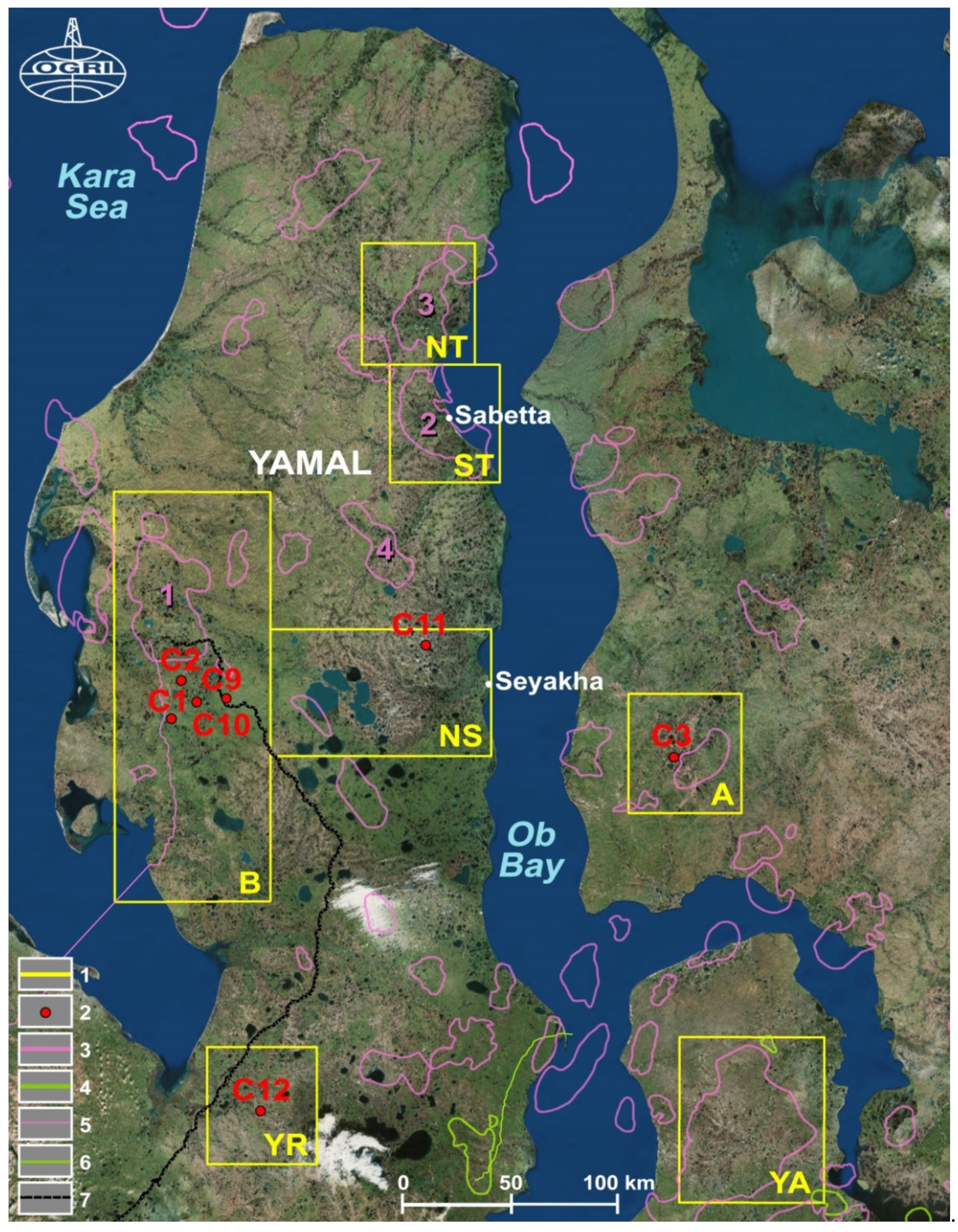

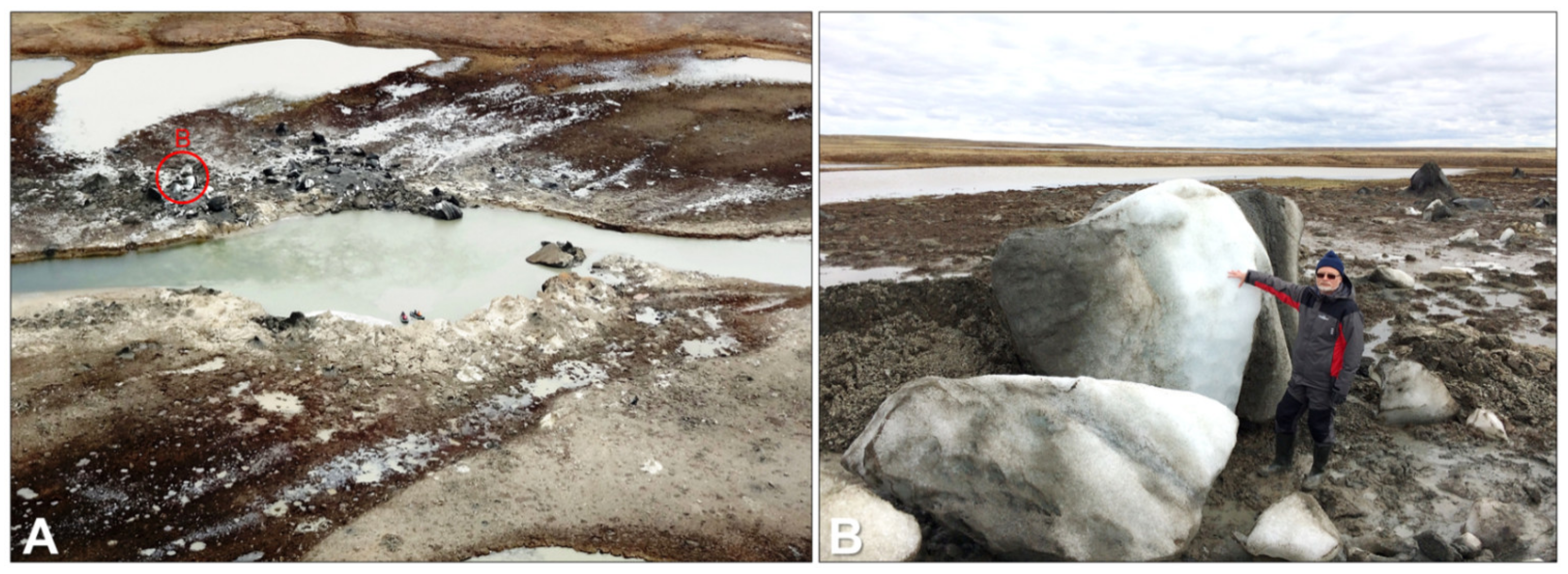
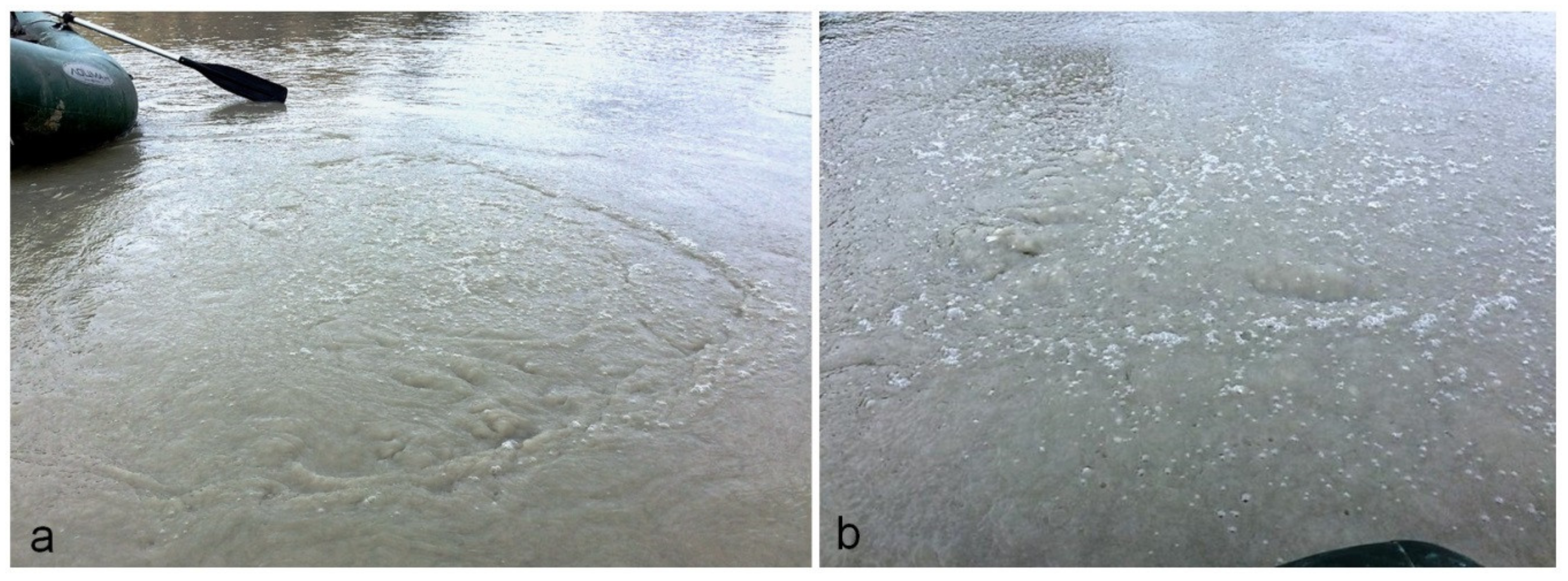


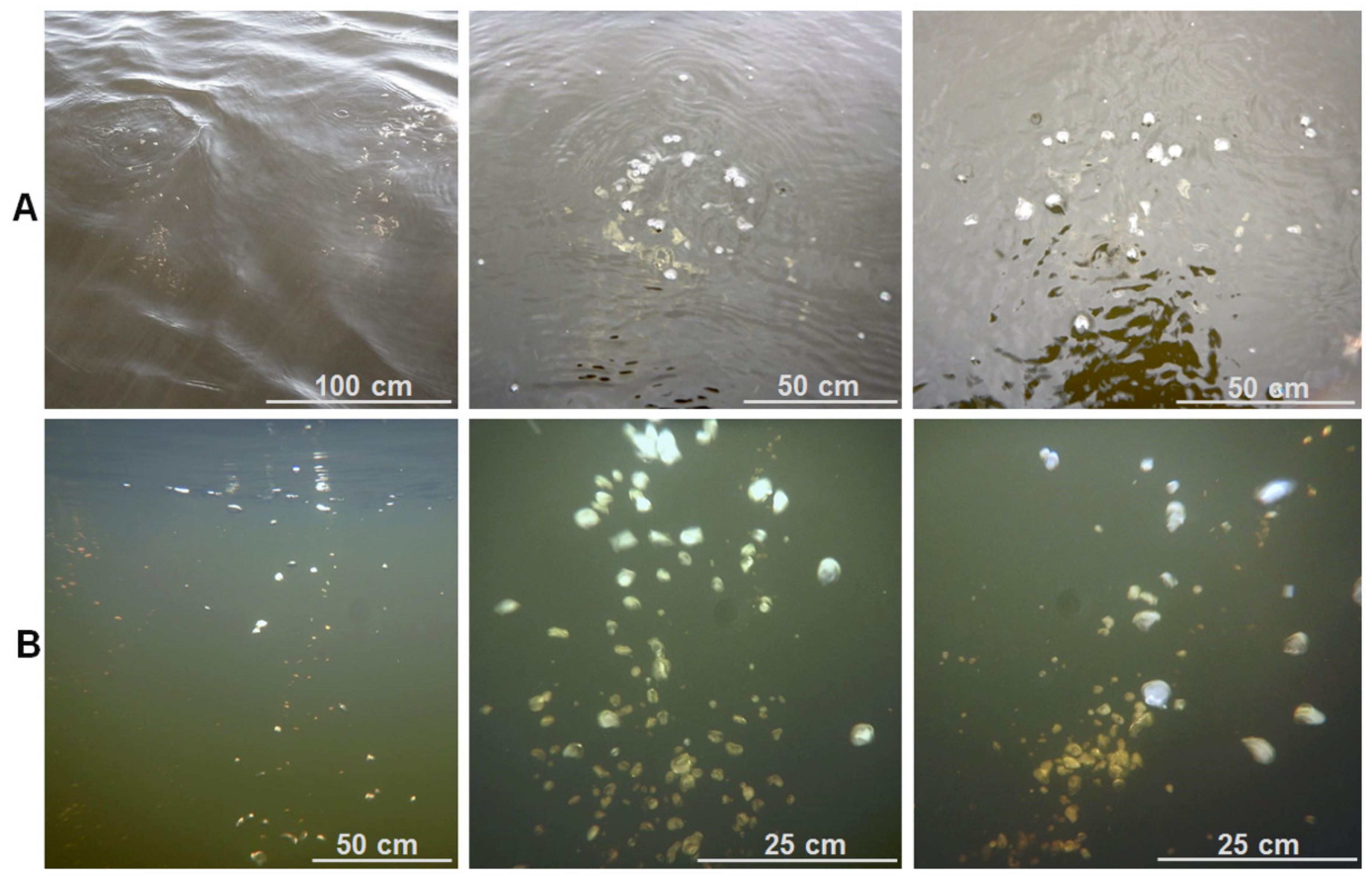
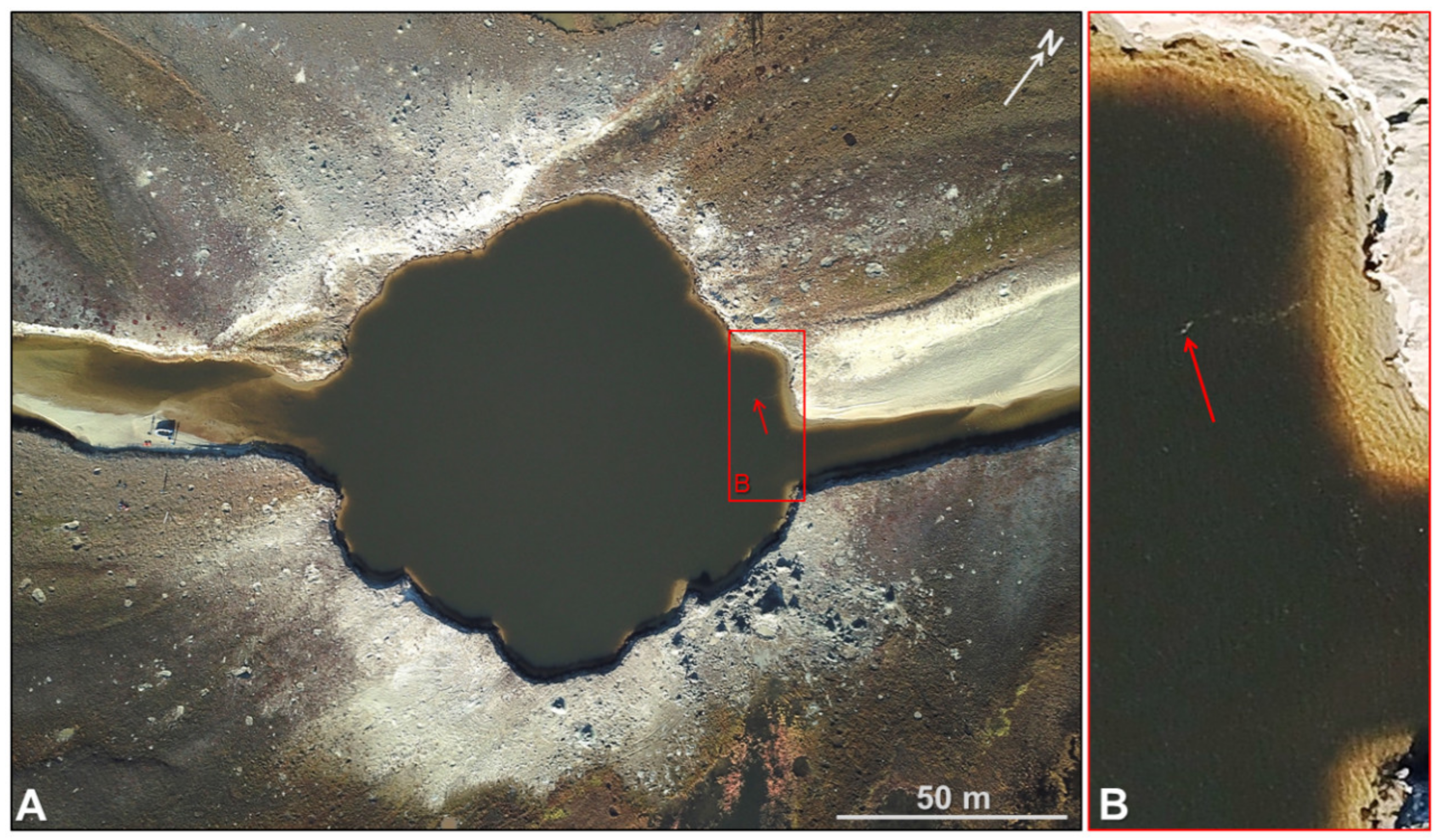
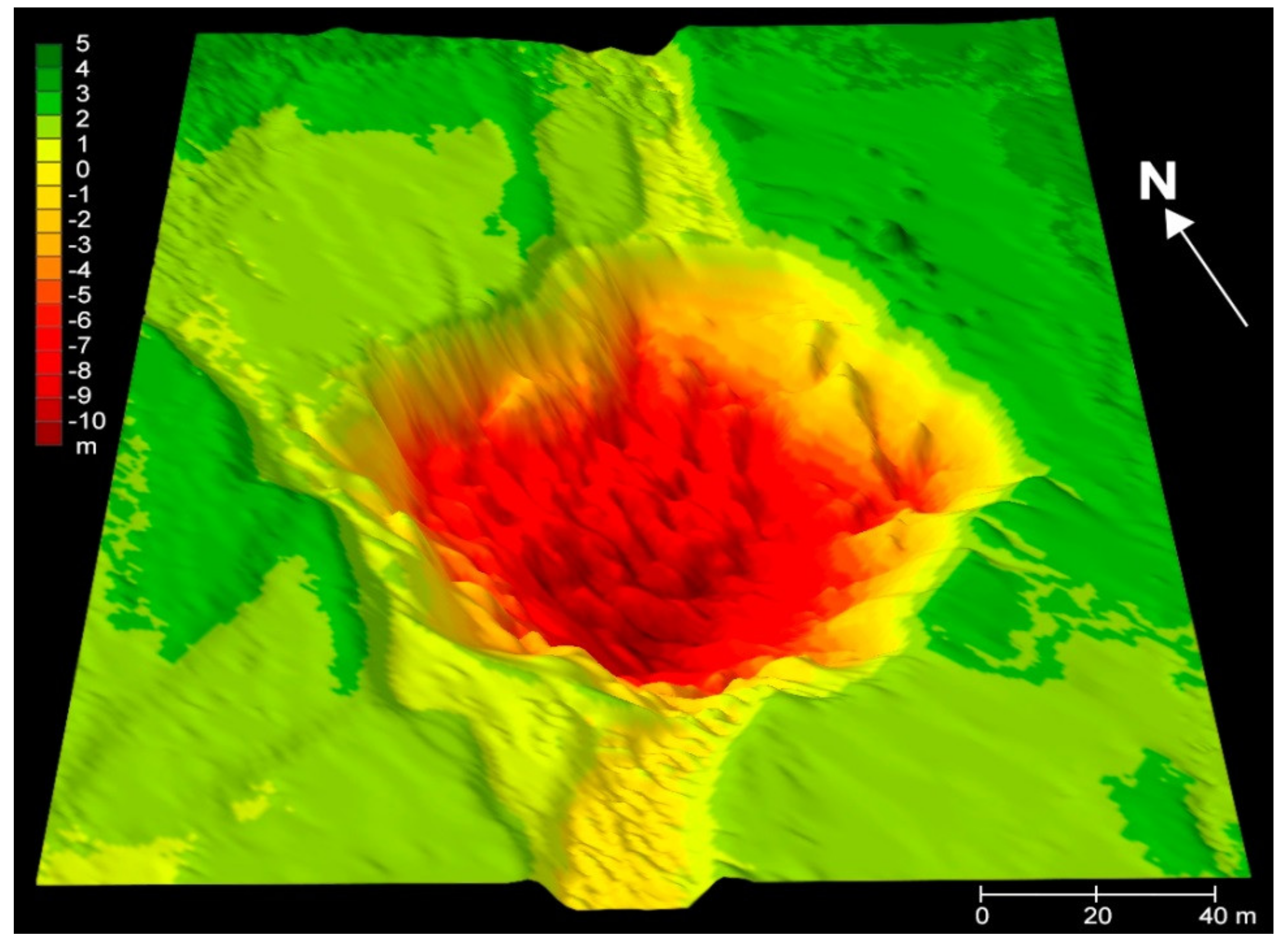

| Date (yyyy.mm.dd) | Information Source | Crater Area, m2 | Crater Area, % | Number of Areas with Seeps | Area of Seeps, m2 | Total Area of Seeps, m2 | Area of Seeps, % | |
|---|---|---|---|---|---|---|---|---|
| Min | Max | |||||||
| 2017.07.02 | HC | 2780 | 100.0 | 7 | 6.3 | 36.7 | 106.1 | 3.82 |
| 2017.07.22 | RP | 4998 | 179.8 | 7 | 6.3 | 36.7 | 106.1 | 2.12 |
| 2017.07.27 | WV-3 | 5237 | 188.4 | 7 | 6.3 | 36.7 | 106.1 | 2.03 |
| 2018.07.16 | RP | 7740 | 278.4 | 6 | 5.9 | 35.5 | 113.4 | 1.47 |
| 2018.07.20 | WV-1 | 8468 | 304.6 | 6 | 5.9 | 35.5 | 113.4 | 1.14 |
| 2018.09.18 | D | 9049 | 325.5 | 6 | 5.9 | 35.5 | 113.4 | 1.25 |
| 2019.08.12 | D | 9113 | 327.8 | 29 | 3.6 | 296.7 | 1036.7 | 11.38 |
| 2020.08.20 | D | 9354 | 336.5 | 27 | 2.3 | 191.1 | 1027.3 | 10.98 |
| Gas | Chromatograph | Gas Content, % of Volume | |
|---|---|---|---|
| Initial | Recalculated | ||
| CH4 | Clarus 500 | 72.99181 | - |
| C2H4+ | Clarus 500 | <0.0001 | - |
| CH4 | “Crystallux-4000 M” | 72.06 | 96.964 |
| CO2 | “Crystallux-4000 M” | 0.0414 | 0.056 |
| O2 | “Crystallux-4000 M” | 7.638 | 2.98 |
| N2 | “Crystallux-4000 M” | 20.17 | 0.0 |
| S.# | Area/Well | Depth, m | Chemical Composition, % Volume | Source of Data | |||
|---|---|---|---|---|---|---|---|
| CH4 | CO2 | N2 | O2 | ||||
| 1 | Crater C11 | >12 | 72.06 | 0.0414 | 20.17 | 7.638 | New data |
| 2 | BW. 51-P-2 | 38–44 | 74.81 | 0.29 | 16.03 | 3.27 | [53] |
| 3 | BW. 52-P-2 | 114–120 | 77.91 | n.d. | 7.33 | n.d. | [27] |
| 4 | BW. 58-P-1 | 100–107 | 71.32 | 0.05 | 21.22 | 4.89 | [27] |
| 5 | BW. 610-P-3 | 54–58 | 65.22 | 0.16 | 27.47 | n.d. | [27] |
| 6 | BW. 610-P-3 | 71–76 | 73.20 | 0.33 | 20.70 | 0.30 | [27] |
| 7 | BW. 51-P-1 | 28–33 | 95.49 | 0.02 | 3.51 | 0.91 | [53] |
| 8 | BW. 51-P-1 | 59–64 | 92.80 | 0.05 | 5.03 | 1.15 | [53] |
| 9 | BW. 51-P-3 | 150–151 | 97.19 | 2.72 | 0.09 | n.d. | [53] |
| 10 | BW. 52-P-1 | 119–123 | 98.02 | 0.08 | 1.9 | n.d. | [53] |
| 11 | BW. 52-P-3 | 89–96 | 99.79 | 0.0 | 0.21 | 0.0 | [53] |
| 12 | BW.56-P-3 | 60–68 | 97.15 | 1.41 | 1.43 | n.d. | [27] |
| 13 | BW. 67-P-3 | 65–68 | 93.17 | 2.36 | 3.46 | 1.01 | [27] |
| 14 | BW. 67-P-3 | 96–160 | 95.78 | 0.09 | 3.39 | 0.74 | [27] |
| 15 | BW. 610-P-2 | 91–95 | 91.88 | 0.06 | 6.30 | 0.11 | [27] |
| 16 | YaW. 1 | 50–100 | 78.3 | 0.3 | 18.4 | 3.0 | [53] |
| 17 | YaW. 2106 | 50–100 | 79.3 | 0.13 | 17.3 | n.d | [53] |
| S.# | Area/Well | Depth, m | δ13C(CH4), ‰ | Source of Data |
|---|---|---|---|---|
| 1 | Crater C11 | >12 | −76.2 | New data |
| 2 | Crater C11 | 56? | −80.6 | [13] |
| 3 | Crater C1 | 20–40? | −45...−84.7 | [43] |
| 4 | BW. 51-P-1 | 28–33 | −73.9 | [27,53] |
| 5 | BW. 51-P-1 | 59–64 | −74.6/−75.1 | [27,53] |
| 6 | BW. 51-P-2 | 38–44 | −72.2/−73.8 | [27,53] |
| 7 | BW. 51-P-3 | 62–69 | −72.3/−74.1 | [27,53] |
| 8 | BW. 52-P-1 | 63–70 | −71.0 | [53] |
| 9 | BW. 52-P-1 | 119–123 | −71.8 | [27] |
| 10 | BW. 52-P-2 | 46–52 | −70.4/−71.8 | [27,53] |
| 11 | BW. 52-P-2 | 114–120 | −70.4/−69.8 | [27,53] |
| 12 | BW. 55-P-1 | 59–64 | −92.1 | [27] |
| 13 | BW. 55-P-3 | 103–113 | −73.6/−70.0 | [27,53] |
| 14 | BW. 56-P-2 | 70–80 | −76.8 | [27] |
| 15 | BW. 58-P-1 | 100–107 | −72.7 | [27] |
| 16 | BW. 58-P-2 | 27 | −59.56 | [27] |
| 17 | BW. 58-P-2 | 105 | −90.41 | [27] |
| 18 | YaW | 0 | −44.4/−46.5 | [4] |
| 19 | YaW | 0 | −70.5/−70.6 | [4] |
Publisher’s Note: MDPI stays neutral with regard to jurisdictional claims in published maps and institutional affiliations. |
© 2021 by the authors. Licensee MDPI, Basel, Switzerland. This article is an open access article distributed under the terms and conditions of the Creative Commons Attribution (CC BY) license (https://creativecommons.org/licenses/by/4.0/).
Share and Cite
Bogoyavlensky, V.; Bogoyavlensky, I.; Nikonov, R.; Yakushev, V.; Sevastyanov, V. Permanent Gas Emission from the Seyakha Crater of Gas Blowout, Yamal Peninsula, Russian Arctic. Energies 2021, 14, 5345. https://doi.org/10.3390/en14175345
Bogoyavlensky V, Bogoyavlensky I, Nikonov R, Yakushev V, Sevastyanov V. Permanent Gas Emission from the Seyakha Crater of Gas Blowout, Yamal Peninsula, Russian Arctic. Energies. 2021; 14(17):5345. https://doi.org/10.3390/en14175345
Chicago/Turabian StyleBogoyavlensky, Vasily, Igor Bogoyavlensky, Roman Nikonov, Vladimir Yakushev, and Viacheslav Sevastyanov. 2021. "Permanent Gas Emission from the Seyakha Crater of Gas Blowout, Yamal Peninsula, Russian Arctic" Energies 14, no. 17: 5345. https://doi.org/10.3390/en14175345
APA StyleBogoyavlensky, V., Bogoyavlensky, I., Nikonov, R., Yakushev, V., & Sevastyanov, V. (2021). Permanent Gas Emission from the Seyakha Crater of Gas Blowout, Yamal Peninsula, Russian Arctic. Energies, 14(17), 5345. https://doi.org/10.3390/en14175345






